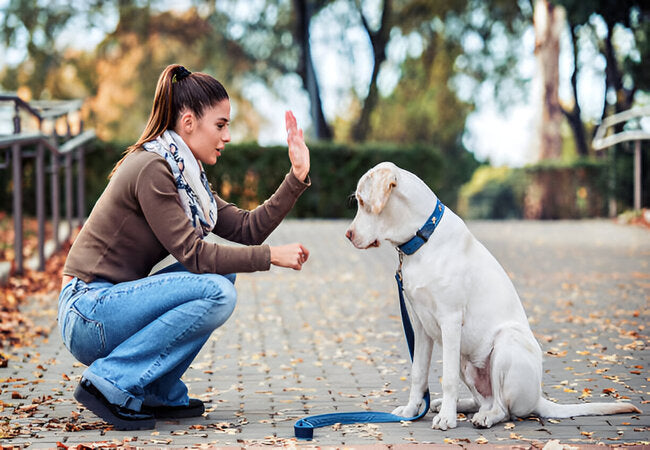Training Dogs the Kind Way: Vet‑Approved 2025 Guide to Positive, Fear-Free Methods 🐶💕

In this article
Training Dogs the Kind Way: Vet‑Approved 2025 Guide to Positive, Fear‑Free Methods 🐶💕
By Dr. Duncan Houston BVSc
You get more flies with honey than with vinegar—yet fear-based methods persist in dog training. As we enter 2025, veterinary behaviorists reaffirm that positive, force‑free training not only fosters better obedience but it avoids fear, anxiety, and aggression in our canine companions. This in-depth, expertly‑sourced guide explains why kindness triumphs over intimidation, how to implement trust‑based techniques, and what to do instead of using force or punishment. Let's explore how training with empathy shapes lifelong bonds! 🐾✨
1. 🐝 Honey vs. Vinegar: Why Kindness Works
Dr. Lisa Radosta, a respected veterinary behaviorist, describes how physical corrections, choke collars, or pain-inducing methods backfire—creating anxiety, resistance, or even aggression. Research in the Journal of Applied Animal Behavior Science confirms: using force leads to defensive responses in up to 25% of dogs.
Fear isn’t obedience. It causes stress and damages trust. Instead, positive reinforcement creates behavior based on understanding, not intimidation.
2. 🧠 Science‑Backed Learning: Positive Reinforcement
- Rewards (food, play, praise) reinforce desired behavior with clarity and joy.
- Clicker training builds precise timing and understanding, fast and effectively.
- Punishment-based or dominance strategies fail to teach “why” a behavior matters—they just suppress it.
3. 🛤️ Clear Boundaries Without Force
Establish structure through predictable cues and consistent rewards. Dogs thrive when they know what’s expected.
- Teach “drop it” through trade‑up methods—offer a treat to voluntarily release objects.
- Use “sit before access” to the beach, door, or treats—focusing on calm compliance.
- Ignore unwanted behaviors like jumping; reward the polite alternative instead.
4. 🧩 When Fear or Aggression Appear
Often, aggression stems from fear or anxiety, not defiance. Use compassion, not dominance:
- Identify root cause: Is it fear of being touched, resource guarding, or new environments?
- Use reward-based desensitization and counterconditioning, starting small and pairing scary triggers with rewards.
- For severe issues, consult a board-certified veterinary behaviorist—safety and expert support are key.
5. 🚫 What to Avoid
- No choke/pinch collars: cause pain and panic.
- No physical forcing: alpha rolls, pinning, or holding dogs down create conflict and mistrust.
- No yelling or intimidation: harsh voices escalate fear and damage relationships.
6. 🛠 Tools for Positive Training
- Clickers and markers: mark good behavior with precision.
- Treats and toys: use meaningful rewards to reinforce learning.
- Life‑rewards: access to play, walks, or freedom becomes a powerful motivator.
7. 📋 Positive Training in Action
| Situation | Typical Punishment | Positive Alternative |
|---|---|---|
| Jumping on guests | Yelling, pushing away | Ignore, ask to sit & reward a calm greeting |
| Stealing food | Snatching, telling off | Trade items for treat; reinforce drop‑it |
| Leash pulling | Yanking, choke | Stop walking, wait, reward slack leash |
8. 🙌 Building Trust and Respect
When dogs learn with kindness, they understand your guidance, feel safe, and choose to participate. This nurtures a respectful, trusting partnership—far beyond obedience.
9. 📱 Ask A Vet App 2025 Support
- 📹 Submit training videos to get feedback on reward timing and body language.
- 🧩 Receive customized positive‑training plans tailored to your dog’s needs.
- 💬 Access live coaching—avoid coercion, build kindness‑based success.
❤️ Final Thoughts
Training with kindness isn't just humane—it’s effective. In 2025, let’s honor our dogs with empathy-based teaching that nurtures trust and reduces fear. Choose boundaries rooted in clarity and reward, not force. Every calm sit, trade, or gentle correction builds a stronger, happier bond. 🐶✨
Want a kindness-based training starter kit? Visit AskAVet.com or download the Ask A Vet app for expert positive‑reinforcement plans, video coaching, and compassionate training guidance—so you and your dog can thrive together!






